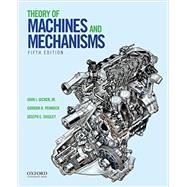Theory of Machines and Mechanisms, Fifth Edition, is an ideal text for the complete study of displacements, velocities, accelerations, and static and dynamic forces required for the proper design of mechanical linkages, cams, and geared systems. The authors present the background, notation, and nomenclature essential for students to understand the various independent technical approaches that exist in the field of mechanisms, kinematics, and dynamics. The fifth edition features streamlined coverage and substantially revised worked examples. This latest edition also includes a greater number of problems, suitable for in-class discussion or homework, at the end of each chapter.
FEATURES
* Offers balanced coverage of all topics by both graphic and analytic methods
* Covers all major analytic approaches
* Provides high-accuracy graphical solutions to exercises, by use of CAD software
* Includes the method of kinematic coefficients and also integrates the coverage of linkages, cams, and geared systems
* An Ancillary Resource Center (ARC) offers an Instructor's Solutions Manual, solutions to 100 of the problems from the text using MatLab, and PowerPoint lecture slides
* A Companion Website includes more than 100 animations of key figures from the text








